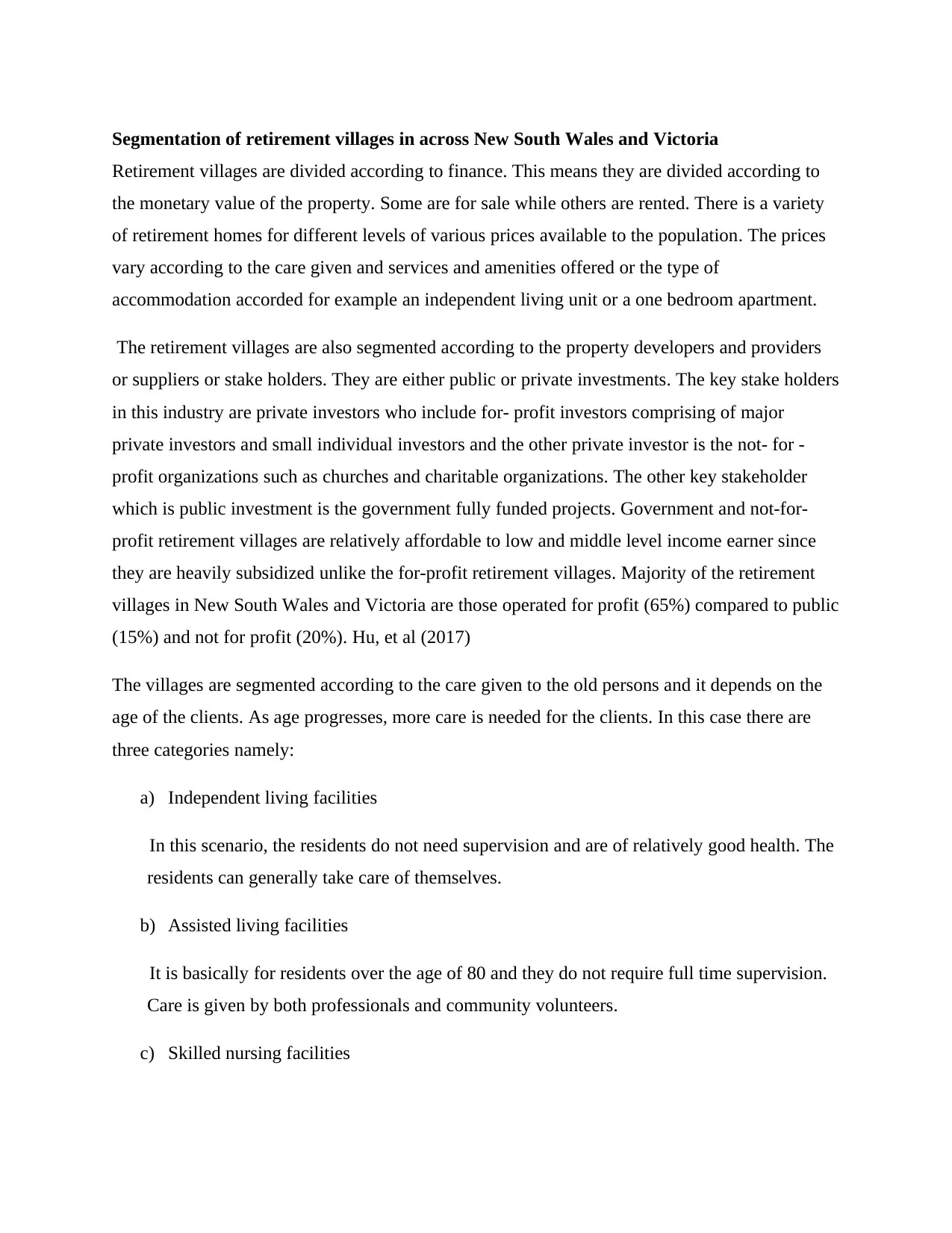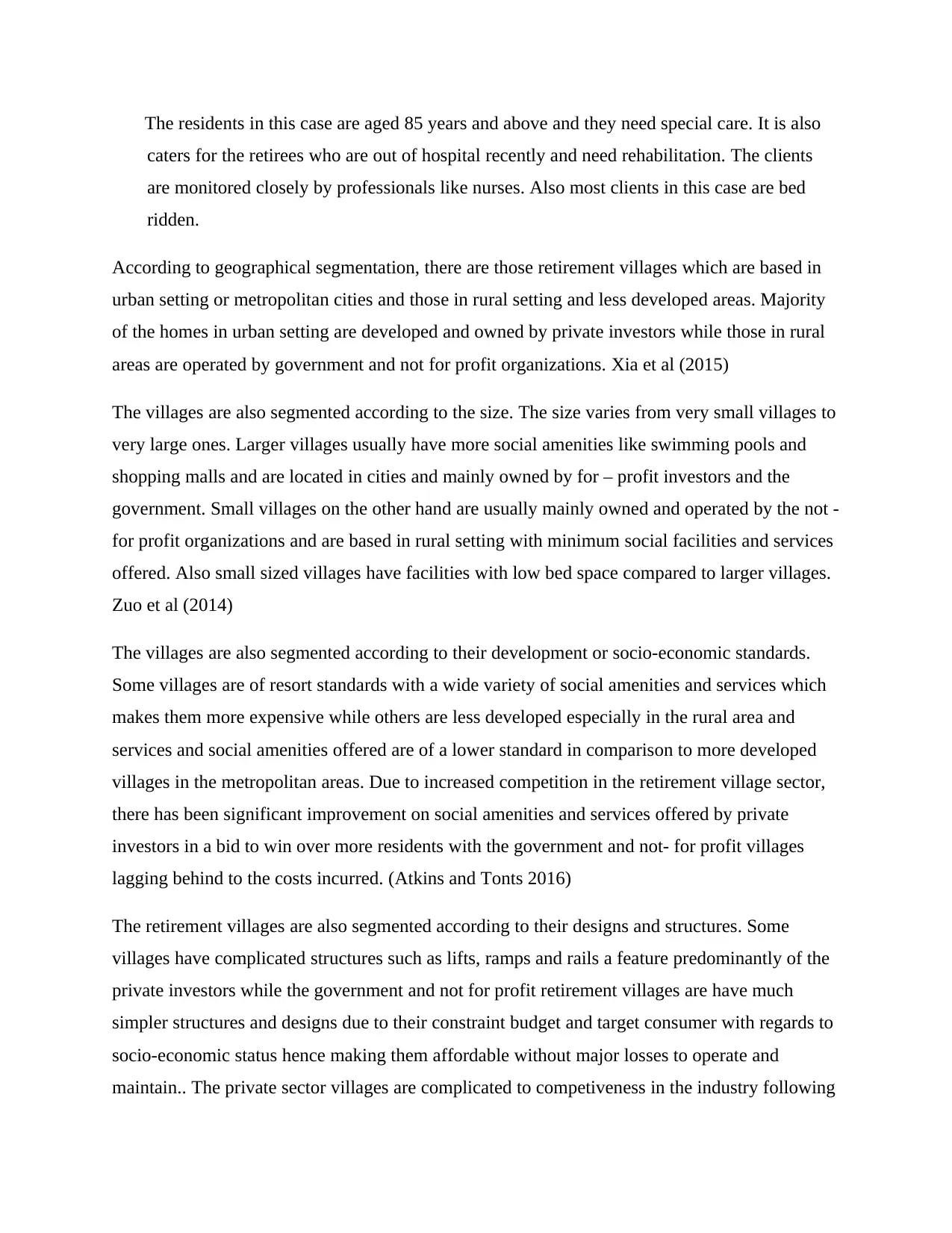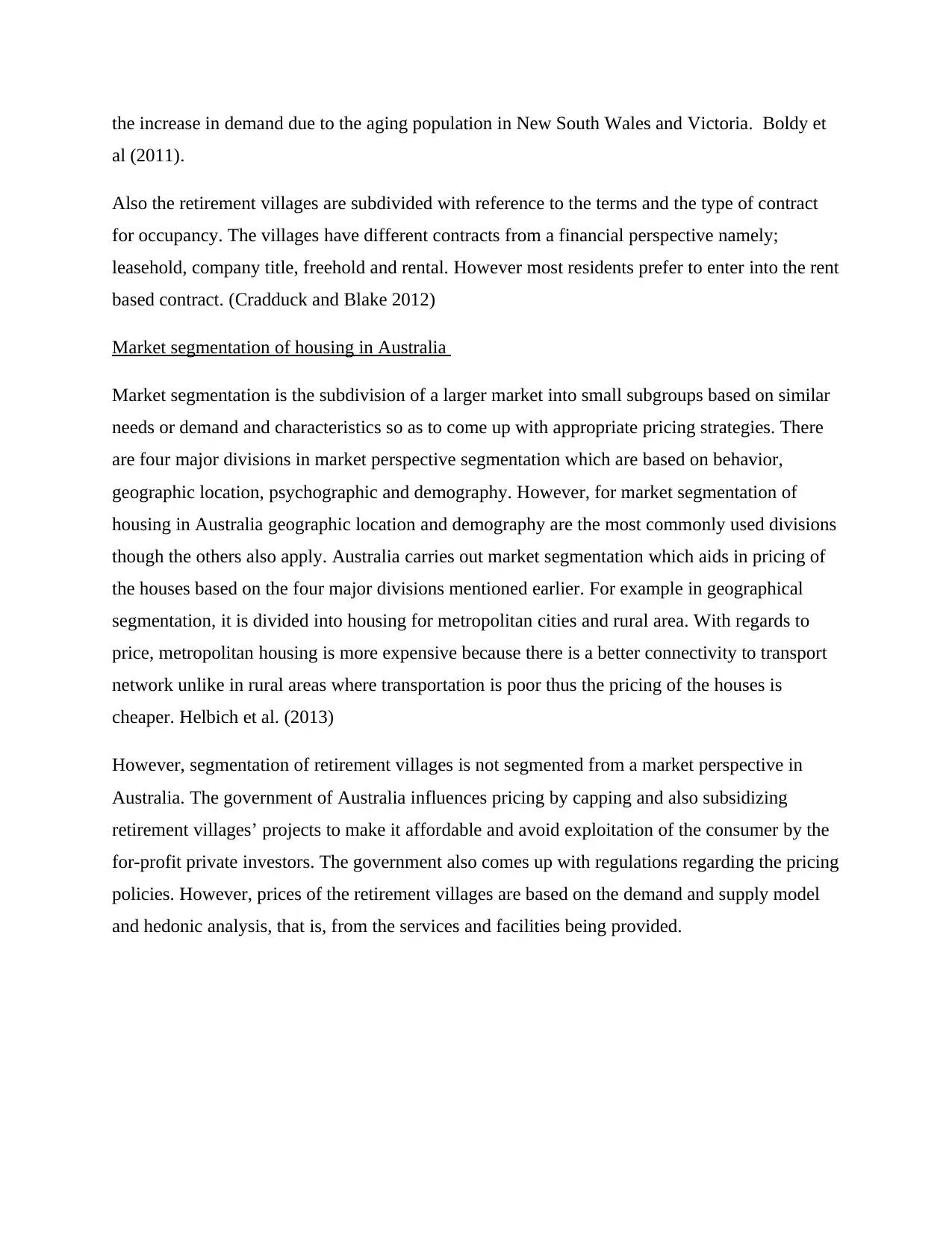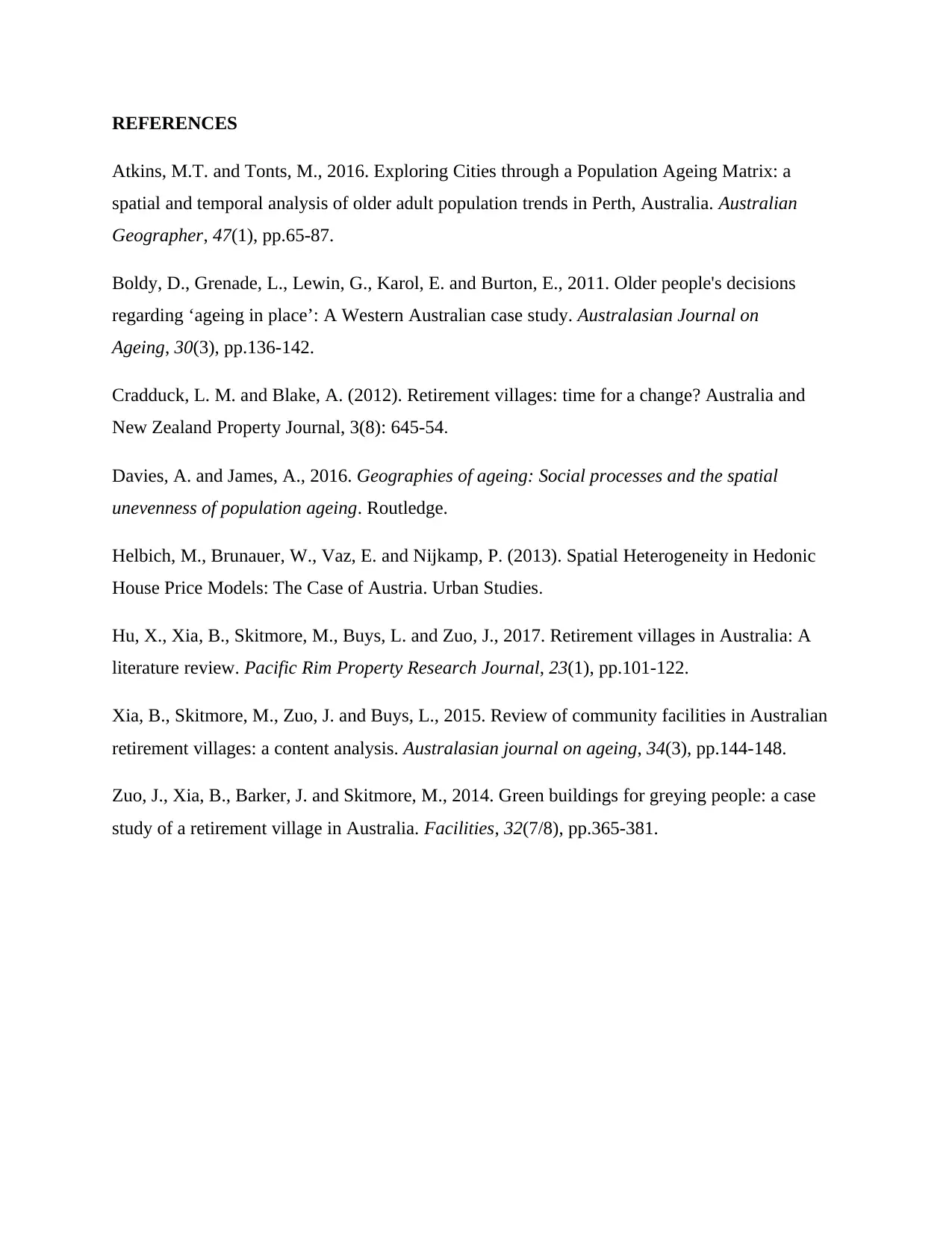A Report on Retirement Village Segmentation in NSW & Victoria, AU
VerifiedAdded on 2023/06/12
|4
|1439
|399
Report
AI Summary
This report examines the segmentation of retirement villages in New South Wales and Victoria, Australia, focusing on financial aspects such as for-sale versus rental options and varying price points based on care levels, services, and accommodation types. The segmentation also considers property developers, distinguishing between public, private (for-profit and not-for-profit), and government-funded projects, highlighting the affordability differences for low to middle-income earners. Furthermore, the report categorizes villages based on the level of care provided (independent, assisted, and skilled nursing facilities), geographical location (urban vs. rural), size (small vs. large), socio-economic standards, designs/structures, and occupancy contract types (leasehold, company title, freehold, rental). It contrasts market segmentation of housing in Australia, where geographic location and demography are key divisions, with the pricing of retirement villages, which is influenced by government regulations, demand-supply dynamics, and hedonic analysis of services and facilities.

Segmentation of retirement villages in across New South Wales and Victoria
Retirement villages are divided according to finance. This means they are divided according to
the monetary value of the property. Some are for sale while others are rented. There is a variety
of retirement homes for different levels of various prices available to the population. The prices
vary according to the care given and services and amenities offered or the type of
accommodation accorded for example an independent living unit or a one bedroom apartment.
The retirement villages are also segmented according to the property developers and providers
or suppliers or stake holders. They are either public or private investments. The key stake holders
in this industry are private investors who include for- profit investors comprising of major
private investors and small individual investors and the other private investor is the not- for -
profit organizations such as churches and charitable organizations. The other key stakeholder
which is public investment is the government fully funded projects. Government and not-for-
profit retirement villages are relatively affordable to low and middle level income earner since
they are heavily subsidized unlike the for-profit retirement villages. Majority of the retirement
villages in New South Wales and Victoria are those operated for profit (65%) compared to public
(15%) and not for profit (20%). Hu, et al (2017)
The villages are segmented according to the care given to the old persons and it depends on the
age of the clients. As age progresses, more care is needed for the clients. In this case there are
three categories namely:
a) Independent living facilities
In this scenario, the residents do not need supervision and are of relatively good health. The
residents can generally take care of themselves.
b) Assisted living facilities
It is basically for residents over the age of 80 and they do not require full time supervision.
Care is given by both professionals and community volunteers.
c) Skilled nursing facilities
Retirement villages are divided according to finance. This means they are divided according to
the monetary value of the property. Some are for sale while others are rented. There is a variety
of retirement homes for different levels of various prices available to the population. The prices
vary according to the care given and services and amenities offered or the type of
accommodation accorded for example an independent living unit or a one bedroom apartment.
The retirement villages are also segmented according to the property developers and providers
or suppliers or stake holders. They are either public or private investments. The key stake holders
in this industry are private investors who include for- profit investors comprising of major
private investors and small individual investors and the other private investor is the not- for -
profit organizations such as churches and charitable organizations. The other key stakeholder
which is public investment is the government fully funded projects. Government and not-for-
profit retirement villages are relatively affordable to low and middle level income earner since
they are heavily subsidized unlike the for-profit retirement villages. Majority of the retirement
villages in New South Wales and Victoria are those operated for profit (65%) compared to public
(15%) and not for profit (20%). Hu, et al (2017)
The villages are segmented according to the care given to the old persons and it depends on the
age of the clients. As age progresses, more care is needed for the clients. In this case there are
three categories namely:
a) Independent living facilities
In this scenario, the residents do not need supervision and are of relatively good health. The
residents can generally take care of themselves.
b) Assisted living facilities
It is basically for residents over the age of 80 and they do not require full time supervision.
Care is given by both professionals and community volunteers.
c) Skilled nursing facilities
Paraphrase This Document
Need a fresh take? Get an instant paraphrase of this document with our AI Paraphraser

The residents in this case are aged 85 years and above and they need special care. It is also
caters for the retirees who are out of hospital recently and need rehabilitation. The clients
are monitored closely by professionals like nurses. Also most clients in this case are bed
ridden.
According to geographical segmentation, there are those retirement villages which are based in
urban setting or metropolitan cities and those in rural setting and less developed areas. Majority
of the homes in urban setting are developed and owned by private investors while those in rural
areas are operated by government and not for profit organizations. Xia et al (2015)
The villages are also segmented according to the size. The size varies from very small villages to
very large ones. Larger villages usually have more social amenities like swimming pools and
shopping malls and are located in cities and mainly owned by for – profit investors and the
government. Small villages on the other hand are usually mainly owned and operated by the not -
for profit organizations and are based in rural setting with minimum social facilities and services
offered. Also small sized villages have facilities with low bed space compared to larger villages.
Zuo et al (2014)
The villages are also segmented according to their development or socio-economic standards.
Some villages are of resort standards with a wide variety of social amenities and services which
makes them more expensive while others are less developed especially in the rural area and
services and social amenities offered are of a lower standard in comparison to more developed
villages in the metropolitan areas. Due to increased competition in the retirement village sector,
there has been significant improvement on social amenities and services offered by private
investors in a bid to win over more residents with the government and not- for profit villages
lagging behind to the costs incurred. (Atkins and Tonts 2016)
The retirement villages are also segmented according to their designs and structures. Some
villages have complicated structures such as lifts, ramps and rails a feature predominantly of the
private investors while the government and not for profit retirement villages are have much
simpler structures and designs due to their constraint budget and target consumer with regards to
socio-economic status hence making them affordable without major losses to operate and
maintain.. The private sector villages are complicated to competiveness in the industry following
caters for the retirees who are out of hospital recently and need rehabilitation. The clients
are monitored closely by professionals like nurses. Also most clients in this case are bed
ridden.
According to geographical segmentation, there are those retirement villages which are based in
urban setting or metropolitan cities and those in rural setting and less developed areas. Majority
of the homes in urban setting are developed and owned by private investors while those in rural
areas are operated by government and not for profit organizations. Xia et al (2015)
The villages are also segmented according to the size. The size varies from very small villages to
very large ones. Larger villages usually have more social amenities like swimming pools and
shopping malls and are located in cities and mainly owned by for – profit investors and the
government. Small villages on the other hand are usually mainly owned and operated by the not -
for profit organizations and are based in rural setting with minimum social facilities and services
offered. Also small sized villages have facilities with low bed space compared to larger villages.
Zuo et al (2014)
The villages are also segmented according to their development or socio-economic standards.
Some villages are of resort standards with a wide variety of social amenities and services which
makes them more expensive while others are less developed especially in the rural area and
services and social amenities offered are of a lower standard in comparison to more developed
villages in the metropolitan areas. Due to increased competition in the retirement village sector,
there has been significant improvement on social amenities and services offered by private
investors in a bid to win over more residents with the government and not- for profit villages
lagging behind to the costs incurred. (Atkins and Tonts 2016)
The retirement villages are also segmented according to their designs and structures. Some
villages have complicated structures such as lifts, ramps and rails a feature predominantly of the
private investors while the government and not for profit retirement villages are have much
simpler structures and designs due to their constraint budget and target consumer with regards to
socio-economic status hence making them affordable without major losses to operate and
maintain.. The private sector villages are complicated to competiveness in the industry following

the increase in demand due to the aging population in New South Wales and Victoria. Boldy et
al (2011).
Also the retirement villages are subdivided with reference to the terms and the type of contract
for occupancy. The villages have different contracts from a financial perspective namely;
leasehold, company title, freehold and rental. However most residents prefer to enter into the rent
based contract. (Cradduck and Blake 2012)
Market segmentation of housing in Australia
Market segmentation is the subdivision of a larger market into small subgroups based on similar
needs or demand and characteristics so as to come up with appropriate pricing strategies. There
are four major divisions in market perspective segmentation which are based on behavior,
geographic location, psychographic and demography. However, for market segmentation of
housing in Australia geographic location and demography are the most commonly used divisions
though the others also apply. Australia carries out market segmentation which aids in pricing of
the houses based on the four major divisions mentioned earlier. For example in geographical
segmentation, it is divided into housing for metropolitan cities and rural area. With regards to
price, metropolitan housing is more expensive because there is a better connectivity to transport
network unlike in rural areas where transportation is poor thus the pricing of the houses is
cheaper. Helbich et al. (2013)
However, segmentation of retirement villages is not segmented from a market perspective in
Australia. The government of Australia influences pricing by capping and also subsidizing
retirement villages’ projects to make it affordable and avoid exploitation of the consumer by the
for-profit private investors. The government also comes up with regulations regarding the pricing
policies. However, prices of the retirement villages are based on the demand and supply model
and hedonic analysis, that is, from the services and facilities being provided.
al (2011).
Also the retirement villages are subdivided with reference to the terms and the type of contract
for occupancy. The villages have different contracts from a financial perspective namely;
leasehold, company title, freehold and rental. However most residents prefer to enter into the rent
based contract. (Cradduck and Blake 2012)
Market segmentation of housing in Australia
Market segmentation is the subdivision of a larger market into small subgroups based on similar
needs or demand and characteristics so as to come up with appropriate pricing strategies. There
are four major divisions in market perspective segmentation which are based on behavior,
geographic location, psychographic and demography. However, for market segmentation of
housing in Australia geographic location and demography are the most commonly used divisions
though the others also apply. Australia carries out market segmentation which aids in pricing of
the houses based on the four major divisions mentioned earlier. For example in geographical
segmentation, it is divided into housing for metropolitan cities and rural area. With regards to
price, metropolitan housing is more expensive because there is a better connectivity to transport
network unlike in rural areas where transportation is poor thus the pricing of the houses is
cheaper. Helbich et al. (2013)
However, segmentation of retirement villages is not segmented from a market perspective in
Australia. The government of Australia influences pricing by capping and also subsidizing
retirement villages’ projects to make it affordable and avoid exploitation of the consumer by the
for-profit private investors. The government also comes up with regulations regarding the pricing
policies. However, prices of the retirement villages are based on the demand and supply model
and hedonic analysis, that is, from the services and facilities being provided.
⊘ This is a preview!⊘
Do you want full access?
Subscribe today to unlock all pages.

Trusted by 1+ million students worldwide

REFERENCES
Atkins, M.T. and Tonts, M., 2016. Exploring Cities through a Population Ageing Matrix: a
spatial and temporal analysis of older adult population trends in Perth, Australia. Australian
Geographer, 47(1), pp.65-87.
Boldy, D., Grenade, L., Lewin, G., Karol, E. and Burton, E., 2011. Older people's decisions
regarding ‘ageing in place’: A Western Australian case study. Australasian Journal on
Ageing, 30(3), pp.136-142.
Cradduck, L. M. and Blake, A. (2012). Retirement villages: time for a change? Australia and
New Zealand Property Journal, 3(8): 645-54.
Davies, A. and James, A., 2016. Geographies of ageing: Social processes and the spatial
unevenness of population ageing. Routledge.
Helbich, M., Brunauer, W., Vaz, E. and Nijkamp, P. (2013). Spatial Heterogeneity in Hedonic
House Price Models: The Case of Austria. Urban Studies.
Hu, X., Xia, B., Skitmore, M., Buys, L. and Zuo, J., 2017. Retirement villages in Australia: A
literature review. Pacific Rim Property Research Journal, 23(1), pp.101-122.
Xia, B., Skitmore, M., Zuo, J. and Buys, L., 2015. Review of community facilities in Australian
retirement villages: a content analysis. Australasian journal on ageing, 34(3), pp.144-148.
Zuo, J., Xia, B., Barker, J. and Skitmore, M., 2014. Green buildings for greying people: a case
study of a retirement village in Australia. Facilities, 32(7/8), pp.365-381.
Atkins, M.T. and Tonts, M., 2016. Exploring Cities through a Population Ageing Matrix: a
spatial and temporal analysis of older adult population trends in Perth, Australia. Australian
Geographer, 47(1), pp.65-87.
Boldy, D., Grenade, L., Lewin, G., Karol, E. and Burton, E., 2011. Older people's decisions
regarding ‘ageing in place’: A Western Australian case study. Australasian Journal on
Ageing, 30(3), pp.136-142.
Cradduck, L. M. and Blake, A. (2012). Retirement villages: time for a change? Australia and
New Zealand Property Journal, 3(8): 645-54.
Davies, A. and James, A., 2016. Geographies of ageing: Social processes and the spatial
unevenness of population ageing. Routledge.
Helbich, M., Brunauer, W., Vaz, E. and Nijkamp, P. (2013). Spatial Heterogeneity in Hedonic
House Price Models: The Case of Austria. Urban Studies.
Hu, X., Xia, B., Skitmore, M., Buys, L. and Zuo, J., 2017. Retirement villages in Australia: A
literature review. Pacific Rim Property Research Journal, 23(1), pp.101-122.
Xia, B., Skitmore, M., Zuo, J. and Buys, L., 2015. Review of community facilities in Australian
retirement villages: a content analysis. Australasian journal on ageing, 34(3), pp.144-148.
Zuo, J., Xia, B., Barker, J. and Skitmore, M., 2014. Green buildings for greying people: a case
study of a retirement village in Australia. Facilities, 32(7/8), pp.365-381.
1 out of 4
Your All-in-One AI-Powered Toolkit for Academic Success.
+13062052269
info@desklib.com
Available 24*7 on WhatsApp / Email
![[object Object]](/_next/static/media/star-bottom.7253800d.svg)
Unlock your academic potential
Copyright © 2020–2025 A2Z Services. All Rights Reserved. Developed and managed by ZUCOL.

